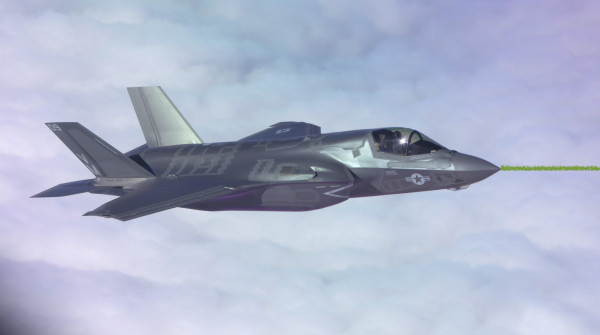

The Defense Department is weighing a plan to deploy F-35 fighters to hover on the outskirts of North Korea airspace and neutralize intercontinental ballistic missiles shortly after launch, Reuters reports.
News of the plan, developed as part of a six-month study on intercepting North Korean ICBMs and conceived as a near-term option, comes as President Donald Trump meets with North Korea’s Kim Jong Un in Vietnam on critical questions surrounding Pyonyang’s nuclear and missile testing programs.
The Pentagon has been toying with novel missile defense strategies for years now: In January, the DoD’s Missile Defense Review presented a milieu of potential options worth further examination, Defense One reported, ranging from drone-based lasers and orbiting missile platforms to reconfiguring the F-35 for missile defense missions.
Indeed, the MDR ” for the testing and development of a new or modified interceptor which could shoot down a ballistic missile in the boost phase,” Defense News noted at the time. “There is also the possibility of using the F-35, equipped with its array of sensors, to hunt and track mobile missile units, which is a key part of North Korea’s doctrine.”

Three F-35C Lightning II, attached to Commander, Joint Strike Fighter Wing, the “Argonauts” of Strike Fighter Squadron (VFA) 147, the “Rough Raiders “Strike Fighter Squadron (VFA) 125 and the “Grim Reapers” Strike Fighter Squadron (VFA) 101 complete a flight overhead Eglin Air Force Base(U.S. Navy/Chief Mass Communication Specialist Shannon E. Renfroe)
Right now, the plan is, well, a pipe dream. An F-35-based ICBM killer ‘calls for interceptor missiles that fly so fast they could melt one expert said, and the only surefire way for U.S. military aircraft to defeat a missile with current technology would be to fly in hostile airspace,” missile defense experts told Reuters.
One possibility exists, however, based on combining two elements proposed in the MDR: Incorporating the drone-based laser concept into the F-35, a la the terrible 1997 miniseries Asteroid, which stars noted missile defense experts Michael Biehn and Annabella Sciorra.

This is absolutely how lasers work(NBC Universal)
It’s not a new concept: Wired notes that the U.S. Missile Defense Agency suspended its Boeing 747-based Airborne Laser Test Bed anti-ICBM system because it “was too costly and unwieldy.” And while the technology has matured significantly in recent years, airborne directed energy weapons are notoriously complicated and frequently short on funding, as with the Air Force Special Operations AC-130J Ghostrider gunship.
But not for long. In 2017, F-35 manufacturer Lockheed Martin was contracted to explore an aircraft-mounded directed energy weapon under the Air Force Research Lab’s Self-Protect High Energy Laser Demonstrator program. The $26 million contract, which builds on the its work for the Army, aims to have a fighter-mounted test weapon by 2021.
An Air Force artist’s conception of a fighter-mounted directed energy weapon(U.S. Air Force Research Lab photo)
“We’re putting a weapon traveling at the speed of light onto an aircraft capable of traveling the speed of sound, while targeting threats likely also traveling at supersonic speeds,” Lockheed laser weapons systems senior fellow Rob Afzal told Wired. “Ruggedization is critical.”
Despite this, the idea of a laser-equipped F-35B hovering near North Korean airspace and slapping missiles out of the sky may remain just an idea. Sure, the F-35 is inching towards real lethality downrange, the ongoing technical and reliability issues facing the F-35 program make the prospect of a complicated directed energy system increasingly improbable.
Oh well. We’ll always have Asteroid.
